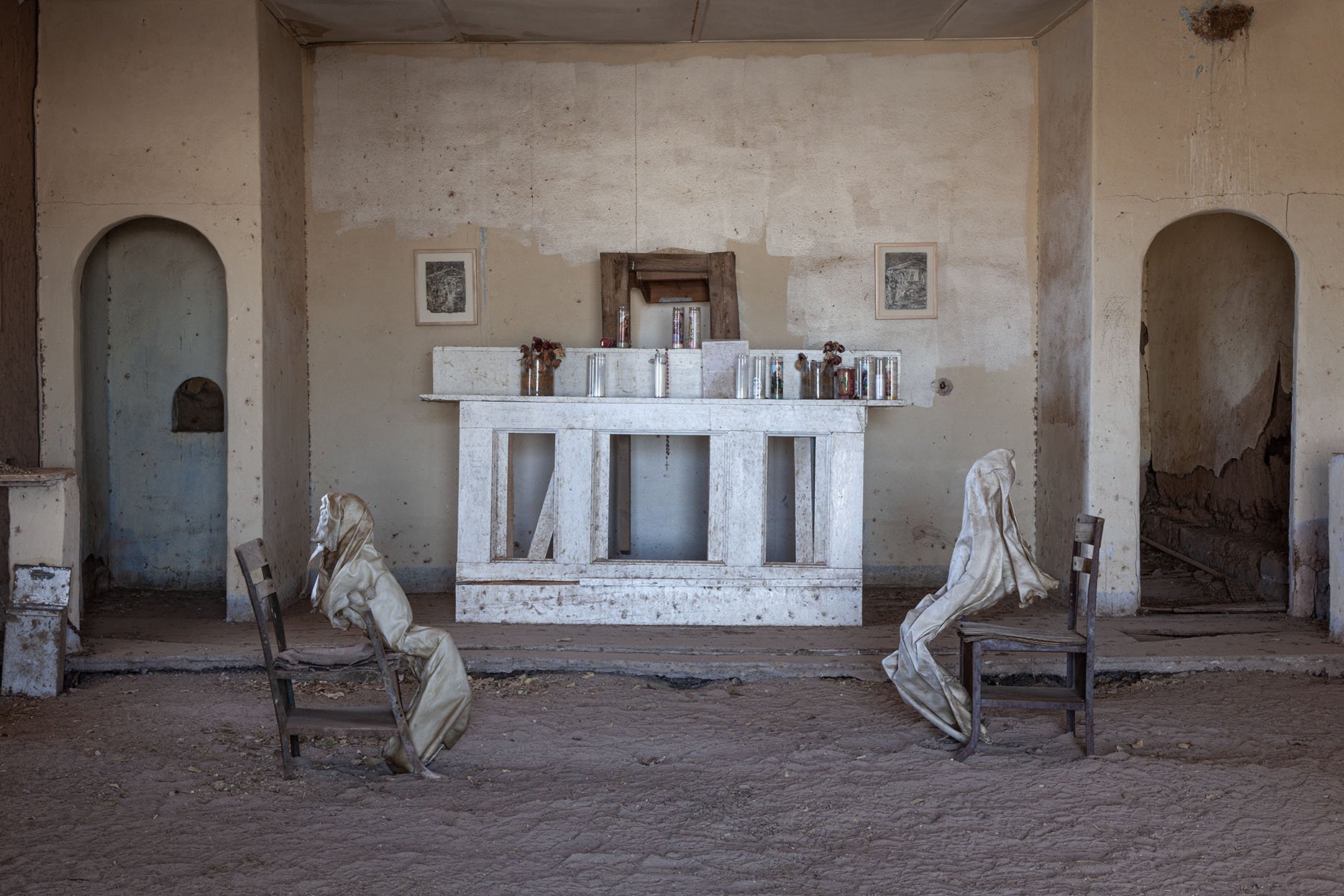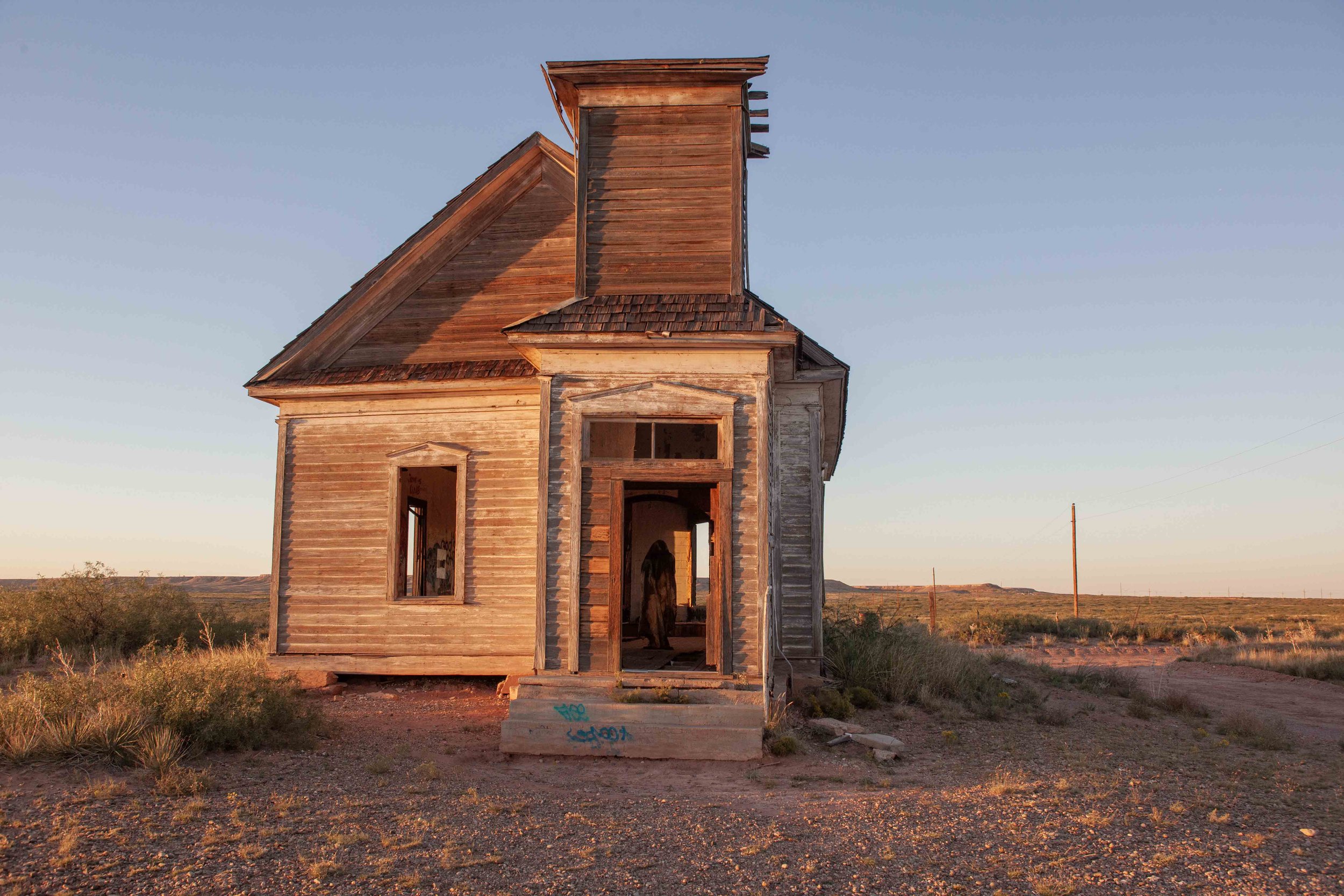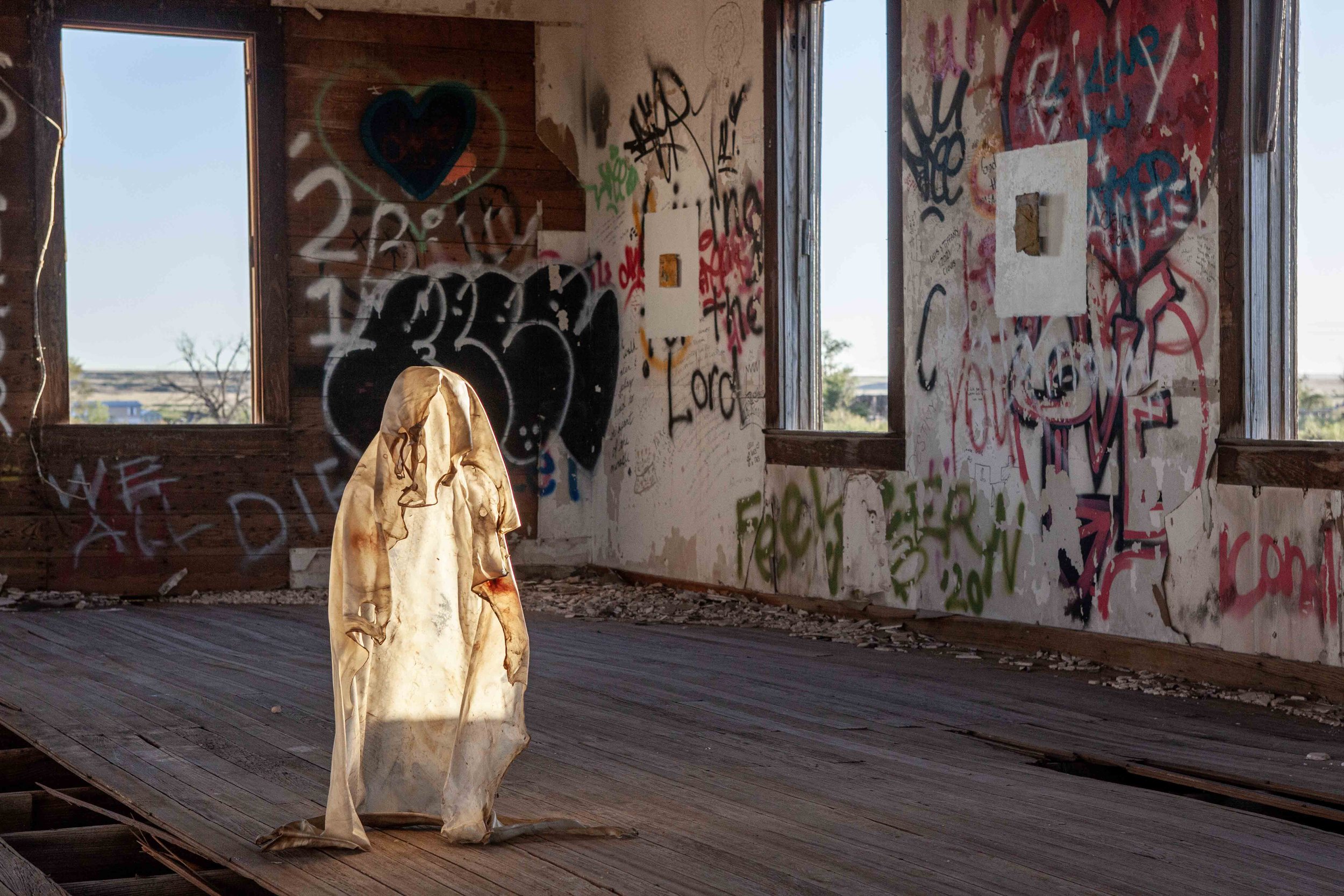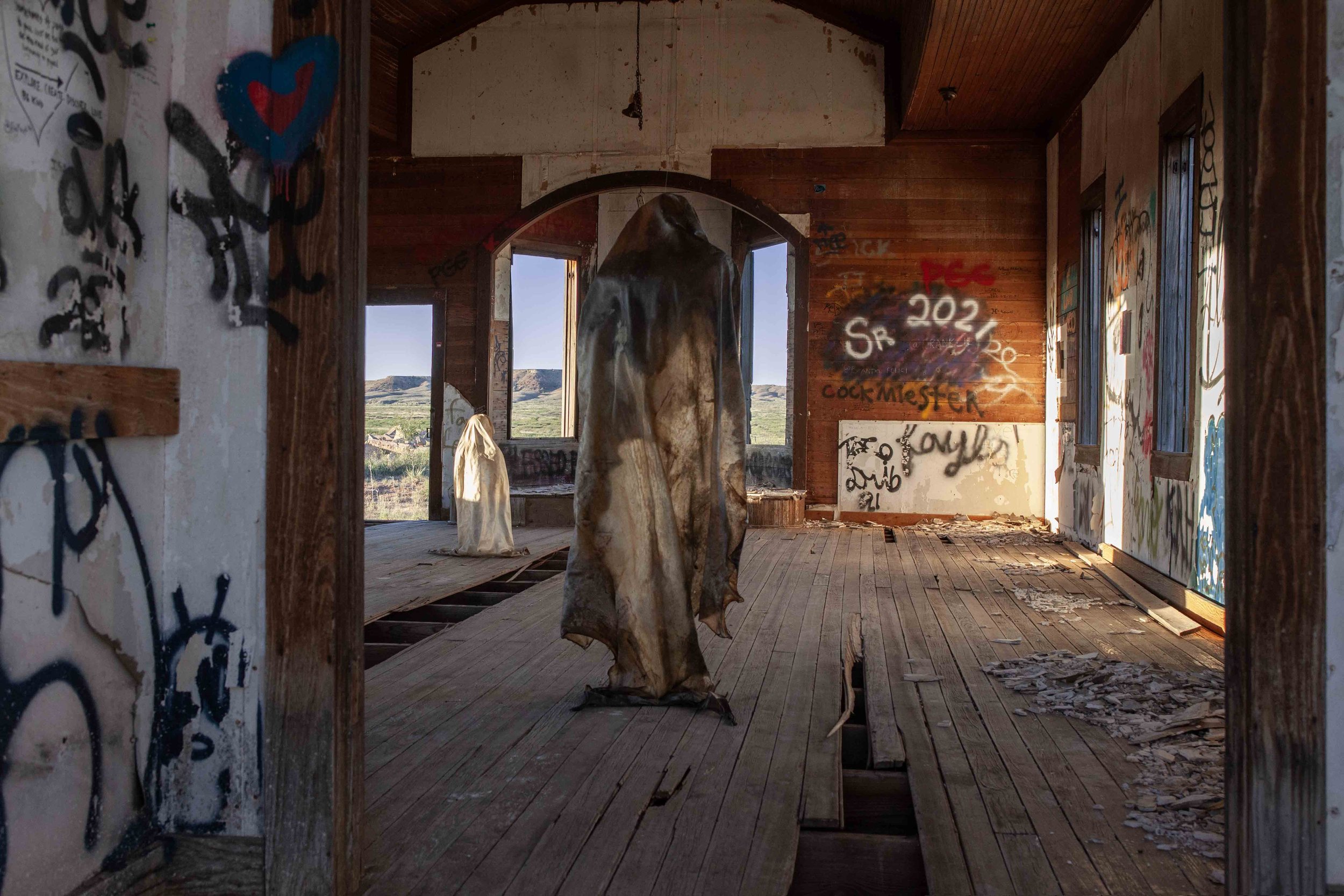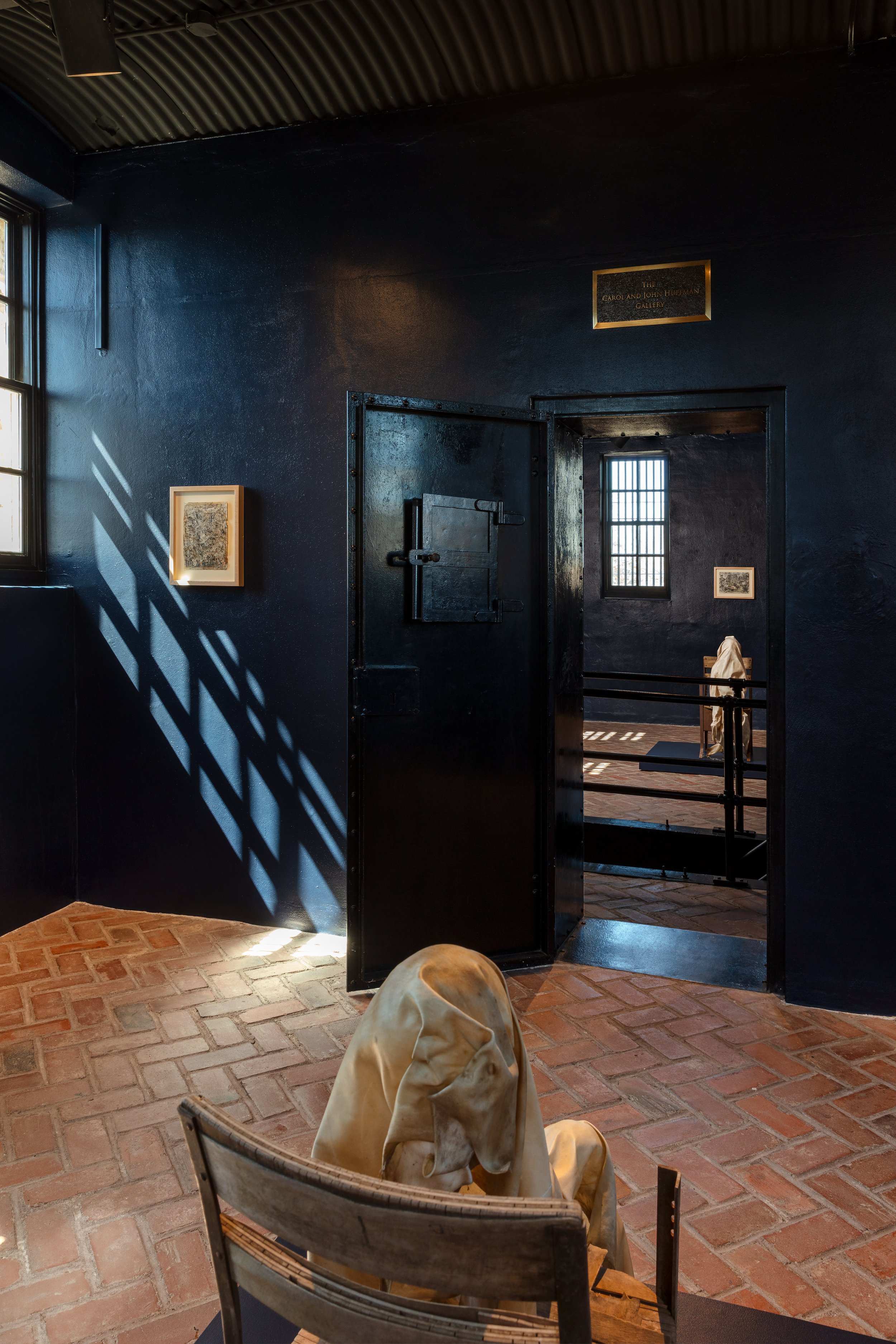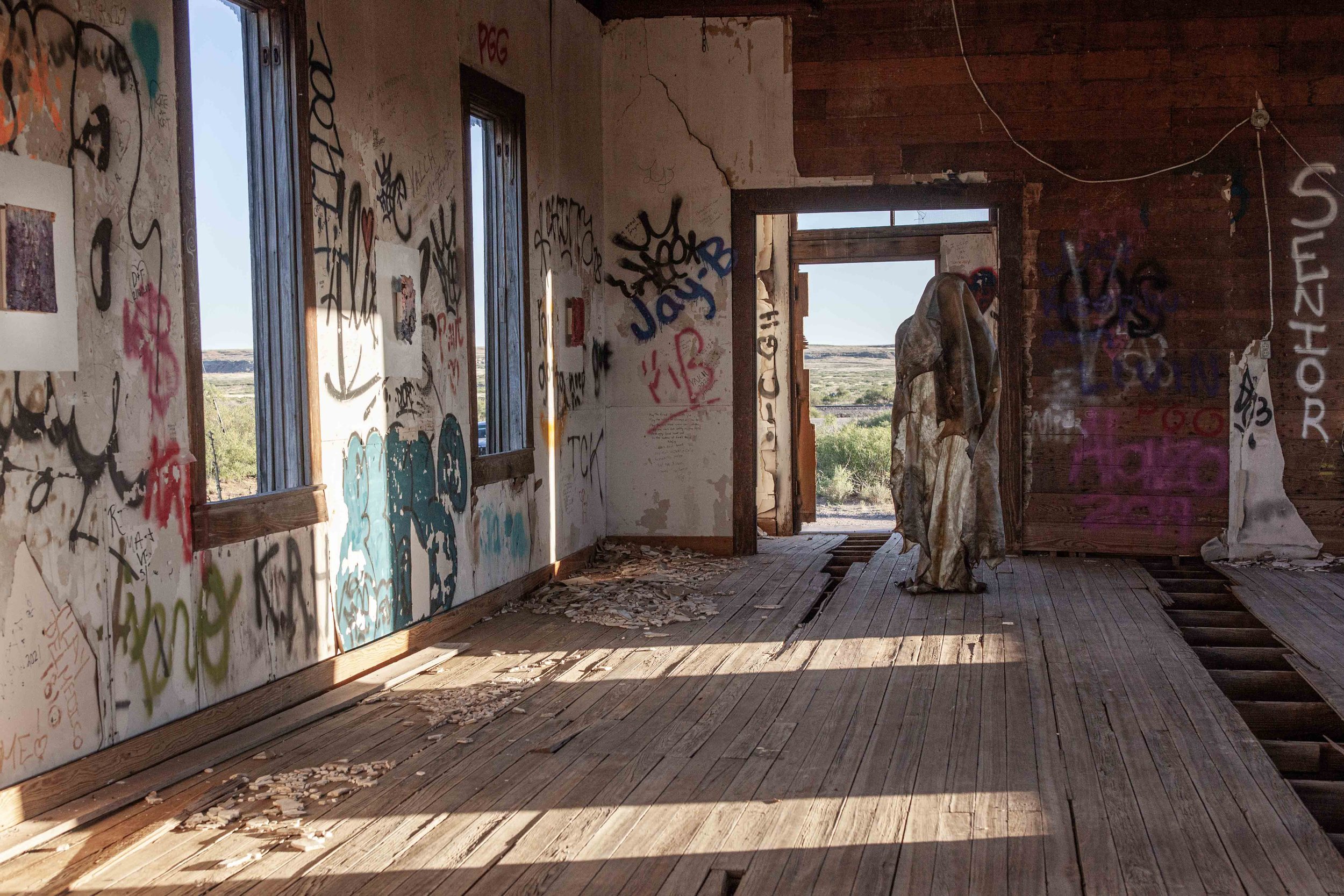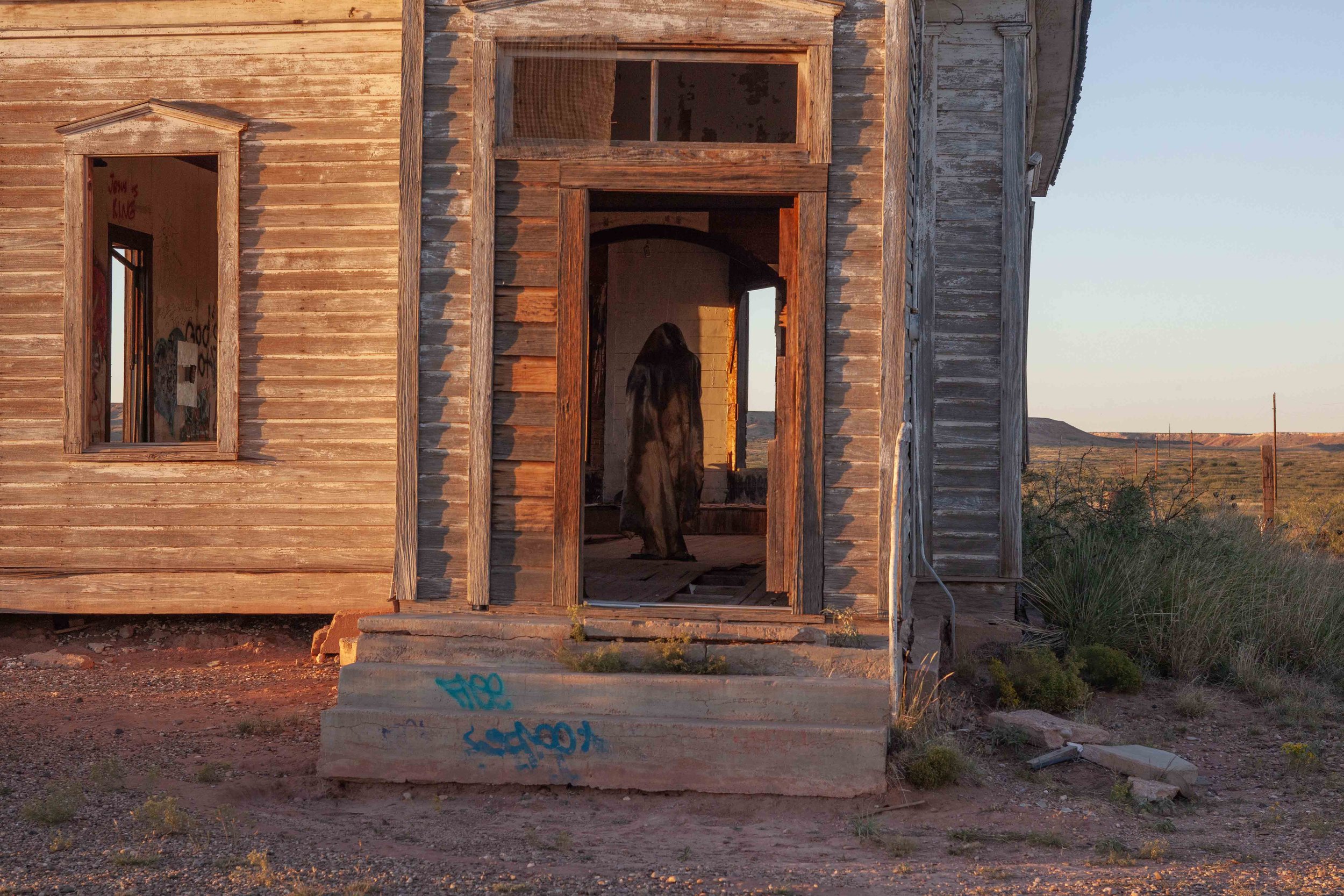“Autumn Pilgrimage” and “Moon in Water”
“Moon in Water” Installation in Abandon Church in San Acacia, New Mexico
How would a child know how the world should be?
A child would have to be born so. A sense of justice is common to the world. All mammals certainly. A dog knows perfectly well what is fair and what is not. He didnt learn it. He came with it. Would you like to get more fanciful?
In for a penny.
More fanciful would be the understanding that the idea of justice and the idea of the human soul are two forms of the same consideration.
You didn’t just come up with that.
No.
What about the animals?
They’re not screaming. Of course fanciful may itself be code for deranged. Anyway, this led pretty directly to the next question.
Which is?
At what age in a child’s life does rage become sorrow?
-Cormac McCarthy, from the novel Stella Maris
“Autumn Pilgrimage” Installation in Abandon Church in Tiaban, New Mexico
In childhood and since, I’ve feared my own disappearance, and have often endured, throughout my life, a sense of the self disappearing. Somehow, it sometimes feels as if I’ve never existed in the first place, like a ghost trying to remember the life it might once have led. Wasn’t I going somewhere? Wasn’t something supposed to have happened?
I’ve written plenty about the Archaic Brother as a personal archetype encompassing the process by which exile and absence are given form. I’ve written about it as the first tenet of Nihil and about the childhood loss of my youngest brother from which the archetype derives much of its original meaning. I’ve written about how, though he would be 38 now, he, in my mind’s eye, grows and ages in parallel with my daughter, now three-and-a-half as I write this. And I’ve related stories of mysterious experiences, how I’ve felt his presence in my own body, electric currents that have seemed to come up from the ground during or after meditation and pulled me to the forest- or desert floor. These experiences have outmatched my clinging to rationality, which is often a kind of self-defense for fear of being disbelieved. My experience of his death was the experience of a disappearance. I’ve written about how he was there and then he wasn’t.
“Moon in Water” Installation in Abandon Church in San Acacia, New Mexico
What I’ve never written publicly is that his death was a theft, a negligence and injustice, which could have been avoided, and for which neither I nor anyone in my family has received closure. I’ve never written that the responsible party was my own father and that his conversion to Evangelical Christianity was largely because of my encouragement that he be Baptized at the church I attended in my teens and early 20’s. That I would soon thereafter leave organized religion behind as I witnessed his new fanaticism, and that he would eventually become a pastor is a story I’ve simply never told any other than a few friends.
In the period following Danny’s death I began speaking everything twice, first in my ordinary voice, and then in a whisper. It was compulsive. For most of the rest of my life, I’ve hated my own voice. Since what I suppose I most feared was not being seen, not being believed, the routine experience of not feeling seen or believed caused me to hate my voice. For if it were a real voice, I would be seen and believed. Though I can’t prove anything, I deeply suspect that my retreat into relative solitude (as compared to average kids) to draw and tell stories in pictures was my way of capturing the repression that came from this experience, and to compensate for what I couldn’t allow of my own voice. I suspect that’s what I did, and what I do.
When I think of that child, myself, in his bedroom alone, trying to make sense of the world through his escape from it, I am filled with amazement and compassion. How did this instinct arise in him? The beauty of this unconscious strategy, to me, is in how it seemed to come from nowhere. No one else in my family made art. I have no memory of a nearby parent or adult expressing any great curiosity or showing a sense of awe about the world. And so it is to this “nowhere” I’ve grown most devoted with time. This transpersonal emptiness, this nighttime garden of inquiry, the nothing which produces everything.
“Autumn Pilgrimage” Installation in Abandon Church in Tiaban, New Mexico
I’ve come to identify the increasing devotion as my own deep yearning to awaken. I do not want the veracity or efficacy of my existence to depend on the chances that my work will be seen and understood as a contemporary of its own time. For to cling to that need for evidence from outside is to resign myself to the ghost of my childhood who, even now, cannot remember his life. Yet the mountains, forests and deserts that surround me contain all the empty places that bring that ghost home. To become attuned to its wakefulness, to listen deeply to the natural world out there—I’m far from the first to point out—is to listen deeply to the natural self in here, and to feel unashamed.
I have not uniquely caused the problems of the world. I deserve to exist and to be considered on the basis of my contributions. I must tell myself this because it’s what I would want to tell my brother. It’s what I will always tell my daughter. We seek awakening in spite of the myriad voices to its contrary, and it’s because of all the unhelpful and counterproductive voices that I can know others need it as much as I do. If I am attuned to the awakening self in the formation of the work, I must trust that the work is able to function independently, in some time and place beyond the horizon of my own life. Yet this deep and total trust is still so difficult to achieve. I grasp it only briefly. In contemplative practice, I find it only to lose it again. The artwork should contain something of those brief numinous encounters so that it might somehow achieve what I still can’t: self-acceptance. It’s own divinity.
“Moon in Water” Installation in Abandon Church in San Acacia, New Mexico
In a way, the sculptural installations “Autumn Pilgrimage” and “Moon in Water” are two variations of the same imagined encounter. It’s a way of turning to my long dead brother and asking, “Are you here?” This is a strange question to ask, not the least of which because even I’m not sure if I mean to ask it literally.
“Autumn Pilgrimage” Installation. Nicodim Gallery. Los Angeles.
In “Autumn Pilgrimage” it had been my intention to make two figures, an adult male and a child. That a second adult figure should appear hovering an inch above the floor was simply the chance result of the process. When the first figure couldn’t support its own weight, I thought to cast a second as a counterbalance that could be fastened to the first, and thus, combining the two halves, would freely stand in the round.
The result was clunky, the poetry lost. It became clear that the figure’s pathos was in its ephemerality, which is to do with the translucent, lightweight horsehide itself. I had only meant to move the second figure out of the way in my studio when I saw its form, as if for the first time, as it was seemingly meant to be seen, lying on the floor. By chance, two figures became three and now formed a straight line: the adult figure approached the child, who approached the prone figure.
If in the original vision, I was following my brother or daughter, now they were following another version of me, asleep, or, perhaps, already long gone. The unexpected formation opened up a new (I want to say) supra-temporal field of imaginal encounter. The past and future came out to play. This, I had to acknowledge is perhaps really just an elaborate form of self-portraiture. For if I can understand my life is not only my own, but the partial sum of those others who come and go within my own life, who precede and proceed me, then so am I to their lives. I exist because they do. They exist because I do.
“Autumn Pilgrimage” Installation in Abandon Church in Tiaban, New Mexico
It was in this mindset that I then approached “Moon in Water.” Although, in the most obvious sense, I imagined each of the deer-hide figures as Mila and Danny, facing each other as children of the same age across this temporal gap—one might say, on either side of the veil—they are not only themselves. It didn’t even occur to me at first that the hides resemble veils, that they are translucent and formed by impressions of the head and body. Someone reading this might know if the noun and verb versions of the word “hide” share an etymology. It seems too good to be true.
“Moon in Water” Installation in Abandon Church in San Acacia, New Mexico
Nihil makes advanced meaning-making illegal to the process, and it was only by the good luck of the hide’s particular aesthetic and the simple fact that my daughter is a real child who exists on the Nihil route, that these kinds of meanings can emerge so readily. As I’ve pointed out many times already, the great and beautiful irony at the center of Nihil is that in trying to work without premeditated meaning, it seems to arise frequently and everywhere, quite without conscious intention. The unconscious seems more readily available where other conscious choices are not.
Yet there are many shadows of doubt cast over the entire Nihil project. In fact, as the project progresses there are more and more. More holes in the plot, more contradictions in its principles, more performance, less of my own anonymity preserved. Some of these early blindspots are so obvious now, they can’t go unnoticed. What has so long been in the background of all of my work, long before Nihil, is the specter of Church. It’s easy to make the claim that installing these in abandoned churches is coincidence, having more to do with what sorts of abandoned buildings are available throughout the vast New Mexico landscape than with the meaning of Church. Yet what sorts of buildings did I expect to find when I started this alongside the state’s many lonely roads? I don’t remember thinking about it all that much then, but the assertions of either “coincidence” or “synchronicity” seem dubious to me now.
I have the strangest feeling that this was a kind of unconscious strategy all along to bring the work into a kind of space of eternal return. It was a way to confront, unconsciously, what the conscious mind wouldn’t previously allow. Installing these in abandoned churches was a sideways attempt at the Archaic Greek principle of Aletheia, by definition a recovery of truth through unconcealed memory in the form of poetry and song. I didn’t simply stumble on the term at some middle stage of the Nihil project; it’s the very word I gave to my daughter as her middle name. How can I pretend it’s coincidence or even synchronicity that where I go and what I make is some deeply felt need to make contact with a past for which I have no ordinary rational access? All attempts at reclamation are also inventions of archetypal forms, a nascent symbolism in lieu of the lives I can’t remember, my own or anyone’s.
“Moon in Water” Installation in Old Jail Art Center in Albany, New Mexico
To be in most any abandoned church is to be inside something which feels very much like an individual human mind. It contains a residue of the sacred, but is largely neglected and unnoticed. The tagging one finds in the interior is alternately hopeful, desperate, loving, hateful, fearful, urgent, crass, horny, juvenile, cryptic, sentimental, empathetic, and hostile. Each of these seems like a fleeting whisper, a passing thought, like any ordinary person experiences on a daily basis, whether or not we take care to notice. The words and images engage the architecture of the church-as-mind, in a kind of practice of sublimating loss into yearning. Just as the tagging does this within architectural ruins, so do my figures and drawings within the ruins of psyche. This is why I’ve written about the manner in which the collection of abandoned spaces I’ve visited and installed work have come to resemble a single architecture of Self, and why, to do so feels as if I’m returning the work to the site from which it came. A desire to create is made a desire to resurrect. What can’t be resurrected is added to the infinity of desires. We can’t be made whole in the shadow of what we can’t remember. Justice and the human soul: two forms of the same consideration. I cannot make the world good through the work that I make, and I receive that news brokenheartedly.
“Autumn Pilgrimage” Installation in Abandon Church in Tiaban, New Mexico
In his essay “The Spider’s Web” the late great poet Charles Simic wrote it best:
On the other side are the poets who trust only the solitary human voice. The lyric poet is almost by definition a traitor to his own people. He is the stranger who speaks that harsh truth that only individual lives are unique and therefore sacred. He may be loved by his people, but his example is also the one to be warned against. The tribe must pull together to face the invading enemy while the lyric poet sits talking to the skull in the graveyard. For that reason he deserves to be exiled, put to death, and remembered.
When I spoke, did anyone hear? Should I whisper it again? When I formed the object with my hands, did anyone see? Should I destroy it and start again? If there is no way to repair the past, no way to make myself real as a “somebody,” but can only haunt, as an anonymous “nobody,” the remains of what has mostly long vanished (as everything eventually does), what, then, is there to do about it? It is a question I expect to live into, over a long course of time, perhaps for the rest of my life, hopefully with good practice and care. Although I would like one day to answer it for myself, I desire even less to be satisfied with false appeasement. I cannot know what dwells on the other side of here, but I will try to trust it in time.
“Autumn Pilgrimage” Installation in Abandon Church in Tiaban, New Mexico
